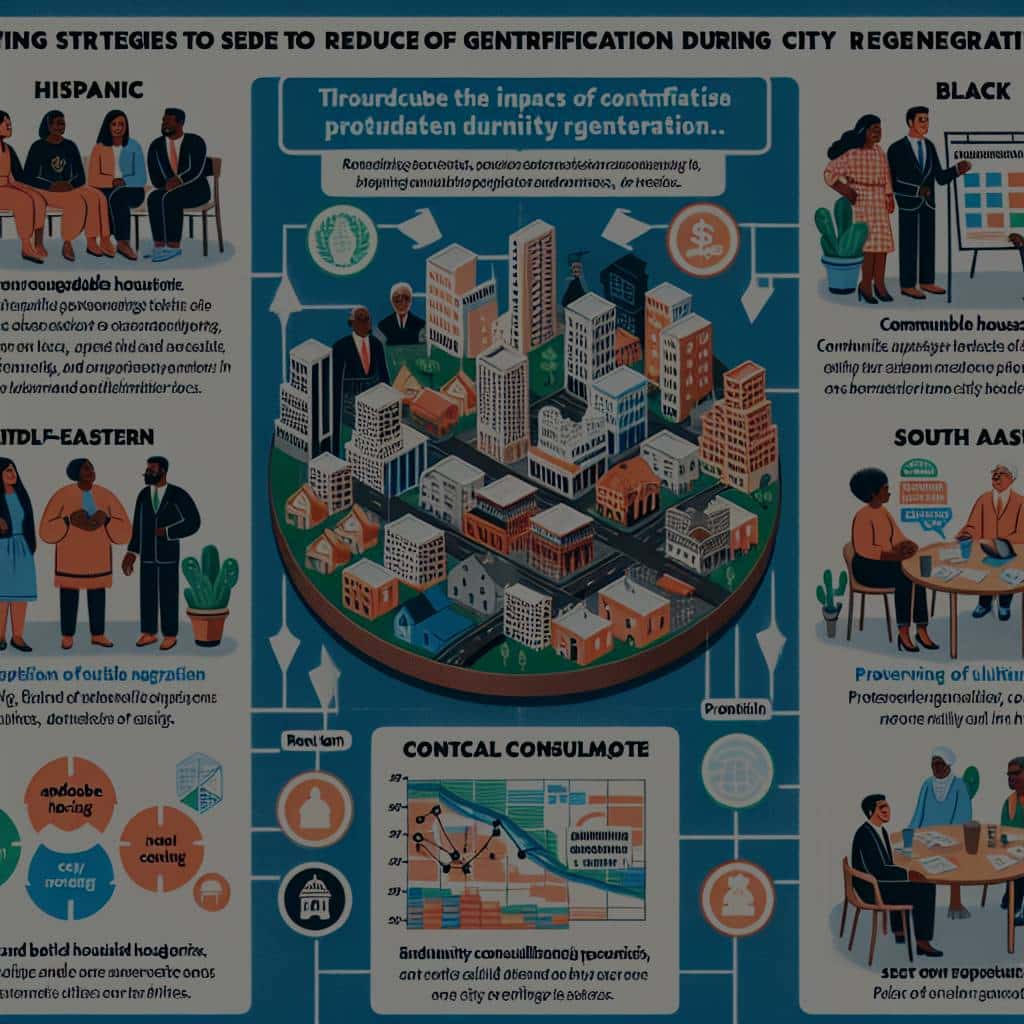What Strategies Can Be Employed to Reduce Gentrification Impacts in City Regeneration?

The urban landscape is ever-evolving. Cities around the world are engaged in a constant process of reinvention, attempting to balance the need for growth and development with the desire to maintain the character and integrity of existing neighborhoods. However, one of the side effects of urban regeneration is gentrification, a term that refers to the process by which higher income individuals displace lower income residents in a particular neighborhood. Gentrification can result in the loss of affordable housing, the disruption of established communities, and the displacement of long-term residents. This article will explore various strategies that can be employed to reduce the impacts of gentrification.
Understanding Gentrification
Gentrification typically involves the influx of higher income individuals into lower income neighborhoods. This process often results in an increase in property values, making it difficult for long-term residents to afford housing in their own communities. While gentrification can bring about certain improvements such as better infrastructure, it often results in displacement and the erosion of a neighborhood’s cultural identity.
Topic to read : How to Implement Passive Solar Design in Urban Homes?
Gentrification is a complex issue and mitigating its effects requires a comprehensive, multifaceted approach. There are no easy answers, but there are strategies that can help manage gentrification and ensure that urban regeneration benefits all residents.
Implementing Anti-Gentrification Policies
The key to effectively managing gentrification lies in the implementation of proactive, anti-gentrification policies. These policies should be designed to ensure that the benefits of urban regeneration are equitably distributed amongst all residents, preventing the displacement of low income individuals.
Also read : How to Secure Real Estate Financing for Self-Build Projects?
One potential strategy involves implementing rent control measures to protect existing residents from skyrocketing housing costs. By limiting the rate at which landlords can increase rent, these measures ensure that housing remains affordable for existing residents. However, rent control is not without its critics who argue that it discourages property investment and leads to a decline in the quality of housing.
Another potential strategy involves offering tax incentives to developers who agree to set aside a certain percentage of new units as affordable housing. This can ensure that the benefits of development are more equitably distributed and that affordable housing remains available in gentrifying neighborhoods.
Engaging in Community-Led Planning
Community-led planning is another impactful strategy for reducing the adverse effects of gentrification. This approach involves the active participation of residents in the planning and development process. By involving residents in decision-making, community-led planning can help to ensure that development reflects the needs and aspirations of the community, thus avoiding the homogenization often associated with gentrification.
Community-led planning can take many forms, from community design charrettes to participatory budgeting. These strategies allow residents to have a say in how their neighborhoods are developed and who benefits from that development.
Promoting Inclusive Growth
Promoting inclusive growth is an effective means of mitigating the impacts of gentrification. This approach involves supporting the growth of local businesses and ensuring that residents have access to good jobs and opportunities within their communities.
By fostering economic diversity within neighborhoods, cities can help to create a more resilient local economy. This inclusive approach to growth ensures that all residents, regardless of income, can benefit from development and regeneration.
Leveraging Public-Private Partnerships
Public-private partnerships (PPPs) can play a significant role in combating the impacts of gentrification. These partnerships involve collaboration between the public sector and private entities to deliver public services or infrastructure. Leveraging PPPs can bring about investment in affordable housing and other essential services in neighborhoods threatened by gentrification.
PPPs have the potential to bring about significant benefits, but they must be carefully managed to ensure that they contribute to equitable development. This means ensuring that the interests of existing residents are prioritized and that affordable housing is preserved in the face of rising property values.
Gentrification is a complex and multifaceted issue, but it’s not an insurmountable challenge. By implementing informed policies, promoting inclusive growth, engaging in community-led planning, and leveraging public-private partnerships, cities can ensure that urban regeneration benefits all residents, helping to create more equitable, inclusive, and vibrant communities. While there are no one-size-fits-all solutions, these strategies offer a starting point for cities looking to address the impacts of gentrification and foster sustainable urban development.
Pursuing Inclusionary Zoning and Land Trusts
A critical strategy for mitigating the effects of gentrification is adopting inclusionary zoning policies and establishing community land trusts. Inclusionary zoning mandates that a specific percentage of housing units in new or rehabilitated projects be reserved for low-income households. This is a proactive approach to ensure that affordable housing remains accessible, especially in gentrifying neighborhoods. Inclusionary zoning laws can make it possible for low-income residents to continue living in their communities despite rising property values and rents.
Community land trusts, on the other hand, offer a different approach. These are nonprofit organizations that hold and manage land on behalf of a community, enabling more sustainable, equitable development. When a community land trust acquires property, it ensures that the housing built on it remains affordable in perpetuity. This strategy can effectively prevent displacement of existing residents, even as their neighborhoods undergo regeneration.
However, these strategies require the active involvement of urban planners and local policymakers. They need robust planning, careful management, and consistent oversight to ensure successful implementation that truly benefits the community.
Enhancing Public Housing Support
Another effective strategy in reducing gentrification’s impact is enhancing public housing support. Public housing programs can provide crucial support to those low-income residents most at risk of displacement due to rising rents and property values. However, these programs often struggle with inadequate funding and mismanagement.
To enhance public housing support, governments need to allocate adequate resources to maintain and improve existing public housing stock. It is also essential to ensure that these housing programs are well-managed and that they serve the needs of the residents effectively and efficiently.
Moreover, strengthening tenant rights and protections can complement public housing programs. Strict enforcement of anti-displacement laws and regulations can help shield vulnerable households from the negative impacts of gentrification.
Conclusion
Gentrification can significantly alter the social, economic, and cultural fabric of urban neighborhoods. While it can bring about positive change, it often leads to displacement, community disruption, and loss of affordable housing. However, by employing comprehensive strategies such as implementing anti-gentrification policies, engaging in community-led planning, promoting inclusive growth, leveraging public-private partnerships, pursuing inclusionary zoning and land trusts, and enhancing public housing support, cities can manage the impacts of gentrification more effectively.
Each city and neighborhood is unique, so there’s no one-size-fits-all solution to gentrification. Still, the strategies discussed provide a starting point for urban planners, policymakers, and community leaders to engage in proactive, thoughtful urban planning. By prioritizing equitable development and inclusivity, cities can ensure that the benefits of urban regeneration are shared by all residents, regardless of income level. As cities continue to grow and evolve, these strategies can help build more resilient, inclusive, and vibrant urban communities that truly serve their residents.
